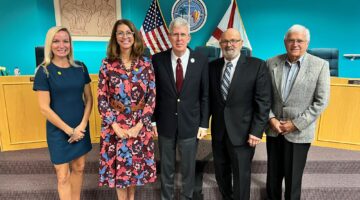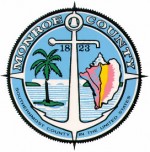Board of County Commissioners Adopts Resolution To Target Greenhouse Gas Emissions Reduction of an Additional 40 % By 2030
KEY LARGO – With Monroe County achieving its first greenhouse gases reduction goal of 20 percent by 2020 several years early, the Board of County Commissioners just adopted a new climate action goal to reduce greenhouse gas emissions in both county operations and community wide by an additional 40% by 2030.
“Here in the Florida Keys, we already are feeling the effects of greenhouse gas emissions with sea level rise,” said Alicia Betancourt, director of Monroe County’s Extension Service, which is working with the Monroe County Sustainability Office on the effort. “Monroe County has been providing leadership in climate issues and this is a big step in that effort.”
If the County reaches this reduction in County operations, it would save taxpayers about $850,000 per year in today’s dollars, Betancourt said.
This new target provides adequate time for significant changes, while remaining aggressive enough to be on track to achieve the long-term goal of 80% global emissions reduction by 2050, according to the Monroe County Greenhouse Gases Executive Summary.
The new 40 percent target is based on the 2012 baseline, which inventoried greenhouse gas emissions from electricity use and fuel for transportation.
The County, a signatory to the U.S. Mayors Climate Protection Agreement and a member of the Southeast Florida Regional Climate Change Compact, set the first 20 percent reduction goal, based on the 2005 emissions baseline.
By 2012, Monroe County exceeded the 20 percent reduction goal. Monroe County’s government operations reduced greenhouse gas emissions by 31 percent. It went from 11.9 metric tons of carbon dioxide equivalent measured in 2005 to 8.2 metric tons in 2012.
In early 2012, the County implemented a number of conservation measures in several County buildings, including those in the Jackson Square complex in Key West that led to reduction of energy use by 23 percent and an annual cost savings of $70,000. That complex includes the Freeman Justice Center, the Lester Building that houses the State Attorney’s Office and the Supervisor of Elections, the Historic Courthouse that houses the Clerk’s Office and the Property Appraiser and the Jefferson Browne Building with the complex’s Chiller Plant.
“We also changed some of our practices and educated our staff,” Betancourt said. “We are no longer keeping the AC low every night in all of our buildings. By bumping the temperature up a little bit, we are saving energy and money.”
The community-wide emissions generated by all residences and businesses was down 22 percent in 2012, going from 1.6 metric tons of carbon dioxide equivalent measured in 2005 to 1.2 million metric tons.
This community reduction includes the “low-hanging fruit,” a one-time transition from municipal solid waste being entirely landfilled to the majority being incinerated in a waste-to-energy facility.
“It will be important to remember when setting future targets that it will be challenging to identify additional climate actions that will be able to reduce emissions at a similar magnitude,” the Executive Summary says.
“So how do we plan to achieve this in roughly 14 years?” Betancourt said at the Board of County Commissioners meeting in Key Largo. “We look at systems’ efficiencies and make sure we’re sticking to building maintenance and repair and looking at it with an eye for energy efficiency. Continuing energy education for employees also is important.”
She said further reduction in the community was “a little trickier,” but added that the BOCC was helping to lead the way with new initiatives for handling waste, moving forward with installations of electrical vehicle charging stations, supporting weatherization for residential homes and supporting solar energy.
[livemarket market_name="KONK Life LiveMarket" limit=3 category=“” show_signup=0 show_more=0]








No Comment